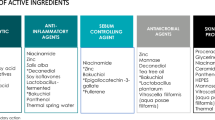Abstract
Apitherapy is a branch of complementary and alternative medicine that uses naturally derived bee products, such as honey, propolis, and bee venom, for their potential health benefits. Historical uses of these agents date back centuries and can be found embedded in the traditions of many cultures and groups. While the mechanism behind each of these products is still poorly understood, a unified theme of antibacterial and anti-inflammatory properties appears to exist. Given their increasing popularity for skin care, many studies are currently investigating the use of bee products in common skin conditions. Although additional research and evidence is needed, it appears there is some potential application for use of these products in the treatment of acne and rosacea. In this chapter, we provide a brief review of the current literature discussing the efficacy of bee products, how they compare to today’s standard medical therapeutic options, as well as discuss potential side effects, risks, and harms that one ought to be aware of when using these agents.
Access this chapter
Tax calculation will be finalised at checkout
Purchases are for personal use only
Similar content being viewed by others
References
Pasupuleti VR, Sammugam L, Ramesh N, Gan SH. Honey, propolis, and royal jelly: a comprehensive review of their biological actions and health benefits. Oxidative Med Cell Longev. 2017;2017:1259510.
Burlando B, Cornara L. Honey in dermatology and skin care: a review. J Cosmet Dermatol. 2013;12(4):306–13.
Molan P, Rhodes T. Honey: a biologic wound dressing. Wounds. 2015;27(6):141–51.
Avni. Honey for acne–use honey to remove acne and its scars. [online]. Available at: https://www.rapidhomeremedies.com/honey-for-acne.html.
Lu J, Carter DA, Turnbull L, Rosendale D, Hedderley D, Stephens J, et al. The effect of New Zealand kanuka, manuka and clover honeys on bacterial growth dynamics and cellular morphology varies according to the species. PLoS One. 2013;8(2):e55898.
Tomblin V, Ferguson LR, Han DY, Murray P, Schlothauer R. Potential pathway of anti-inflammatory effect by New Zealand honeys. Int J Gen Med. 2014;7:149–58.
Gannabathula S, Skinner MA, Rosendale D, Greenwood JM, Mutukumira AN, Steinhorn G, et al. Arabinogalactan proteins contribute to the immunostimulatory properties of New Zealand honeys. Immunopharmacol Immunotoxicol. 2012;34(4):598–607.
Holt S. A New Zealand topical kanuka honey product can treat rosacea and reduce antibiotic resistance. Adv Integr Med. 2015;2(3):141–2.
Semprini A, Braithwaite I, Corin A, Sheahan D, Tofield C, Helm C, et al. Randomised controlled trial of topical kanuka honey for the treatment of acne. BMJ Open. 2016;6(2):e009448.
Braithwaite I, Hunt A, Riley J, Fingleton J, Kocks J, Corin A, et al. Randomised controlled trial of topical kanuka honey for the treatment of rosacea. BMJ Open. 2015;5(6):e007651.
van Zuuren EJ, Graber MA, Hollis S, Chaudhry M, Gupta AK, Gover M. Interventions for rosacea. Cochrane Database Syst Rev. 2005;20(3):CD003262.
Fingleton J, Sheahan D, Cave N, Brinded A, Weatherall M, Perrin K, et al. Topical kanuka honey for the treatment of rosacea. Focus Alternat Complement Ther. 2013;18(4):221–2.
Mandal MD, Mandal S. Honey: its medicinal property and antibacterial activity. Asian Pac J Trop Biomed. 2011;1(2):154–60.
Olah A, Toth BI, Borbiro I, Sugawara K, Szollosi AG, Czifra G, et al. Cannabidiol exerts sebostatic and antiinflammatory effects on human sebocytes. J Clin Invest. 2014;124(9):3713–24.
de Groot AC. Propolis: a review of properties, applications, chemical composition, contact allergy, and other adverse effects. Dermatitis. 2013;24(6):263–82.
Mohammad Ali BM, Ghoname NF, Hodeib AA, Elbadawy MA. Significance of topical propolis in the treatment of facial acne vulgaris. Egypt J Dermatol Venerol. 2015;35:29–36.
Mazzarello V, Donadu MG, Ferrari M, Piga G, Usai D, Zanetti S, et al. Treatment of acne with a combination of propolis, tea tree oil, and Aloe vera compared to erythromycin cream: two double-blind investigations. Clin Pharmacol. 2018;10:175–81.
Toreti VC, Sato HH, Pastore GM, Park YK. Recent progress of propolis for its biological and chemical compositions and its botanical origin. Evid Based Complement Alternat Med. 2013;2013:697390.
Freedman J, Griggs J, De Padova MP, Tosti A. What’s the “buzz” about propolis? Propolis-induced systemic contact dermatitis. Contact Dermatitis. 2019;80(1):65–7.
Ali M. Studies on bee venom and its medical uses. Int J Adv Res Technol. 2012;1(2):69–83.
Han SM, Pak SC, Nicholls YM, Macfarlane N. Evaluation of anti-acne property of purified bee venom serum in humans. J Cosmet Dermatol. 2016;15(4):324–9.
Zaenglein AL, Pathy AL, Schlosser BJ, Alikhan A, Baldwin HE, Berson DS, et al. Guidelines of care for the management of acne vulgaris. J Am Acad Dermatol. 2016;74(5):945–73.
Han SM, Lee KG, Pak SC. Effects of cosmetics containing purified honeybee (Apis mellifera L.) venom on acne vulgaris. J Integr Med. 2013;11(5):320–6.
Han S, Lee K, Yeo J, Kweon H, Woo S, Lee M, et al. Inhibitory effect of bee venom against ultraviolet B induced MMP-11 and MMP-3 in human dermal fibroblasts. J Apic Res. 2007;46(2):94–8.
Han SM, Hong IP, Woo SO, Chun SN, Park KK, Nicholls YM, et al. The beneficial effects of honeybee-venom serum on facial wrinkles in humans. Clin Interv Aging. 2015;10:1587–92.
New You website. Editorial: the price of beauty – Bee-Tox. [online]. Available at: https://www.newyou.com/beauty/price-beauty/.
BeeBio website. Clinically proven results. [online]. Available at: https://beebioskin.com/pages/clinically-proven-results.
Author information
Authors and Affiliations
Editor information
Editors and Affiliations
Rights and permissions
Copyright information
© 2021 Springer Nature Switzerland AG
About this chapter
Cite this chapter
Chandan, N., Dill, S. (2021). Bee Products. In: Rupani, R.N., Lio, P.A. (eds) Integrative Dermatology. Springer, Cham. https://doi.org/10.1007/978-3-030-58954-7_6
Download citation
DOI: https://doi.org/10.1007/978-3-030-58954-7_6
Published:
Publisher Name: Springer, Cham
Print ISBN: 978-3-030-58953-0
Online ISBN: 978-3-030-58954-7
eBook Packages: MedicineMedicine (R0)



